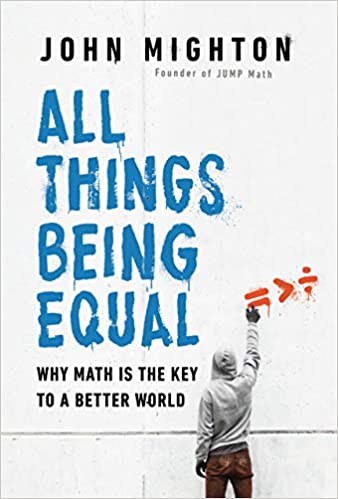This post continues a number of post were I kind of reviewed books that I read and thought it would be helpful to share them with other readers. All Things Being Equal: Why Math Is the Key to a Better World by John Mighton is such a book that deserves to be shared and read by people who care about math education, their children’s math education and math in general. The title of this post is not a mere gimmick, but it means that good books always mention or reference other authors or books that worth reading. This is what exactly happened when I read the book by Anders Ericsson that I mentioned in the previous post. In the Peak Ericsson mentioned John Mighton a Canadian mathematician that incorporated elements of deliberate practice with clear goals and problems that had increasing level of difficulty to teach math to children. This approach is now known as JUMP Math and it is taught to thousands of kids helping them master mathematics while enjoying the subject, unlike in the usual way math is taught in schools.
What is so interesting about this book?
I am past 1/3 of the book, and so far I wasn’t disappointed. The book itself is not only about teaching math to kids. John Mighton discussed also psychological approaches, such as a research into Expertise that plays important role in education in general and in math in particular. He also provides us with an interesting observation that usual math education results in the same distribution of grades among pupils of public schools and among pupils in private schools. It worth mentioning, intellectual poverty a term he coined to emphasize that even though there is a research in to expertise that resulted in clear guidance on how to effectively approach teaching, we as a society still do not incorporate this approach, and what we get is a suboptimal outcome, where kids dislike math, since they think they are not good at it, they have no innate ability or inclination towards it.
Apart from this, John Mighton incorporates a number of examples from math lessons at schools, where he shed light on some of the arithmetic operations that are usually taught as a mere algorithms, without explaining how they work and why. For example, he provides a neat explanation why one could substitute a division of a number by a fraction, by a multiplication of the inverse of that fraction.
Overall
The book is worth reading, since it provides a fresh approach to teaching math to kids and adults alike, in an engaging and exciting way, where kids are gently guided by discovering math step by step, building on the knowledge they gain at a previous step, facing gradually increasing challenges along the way.

One thought on “Good books come in tuples”